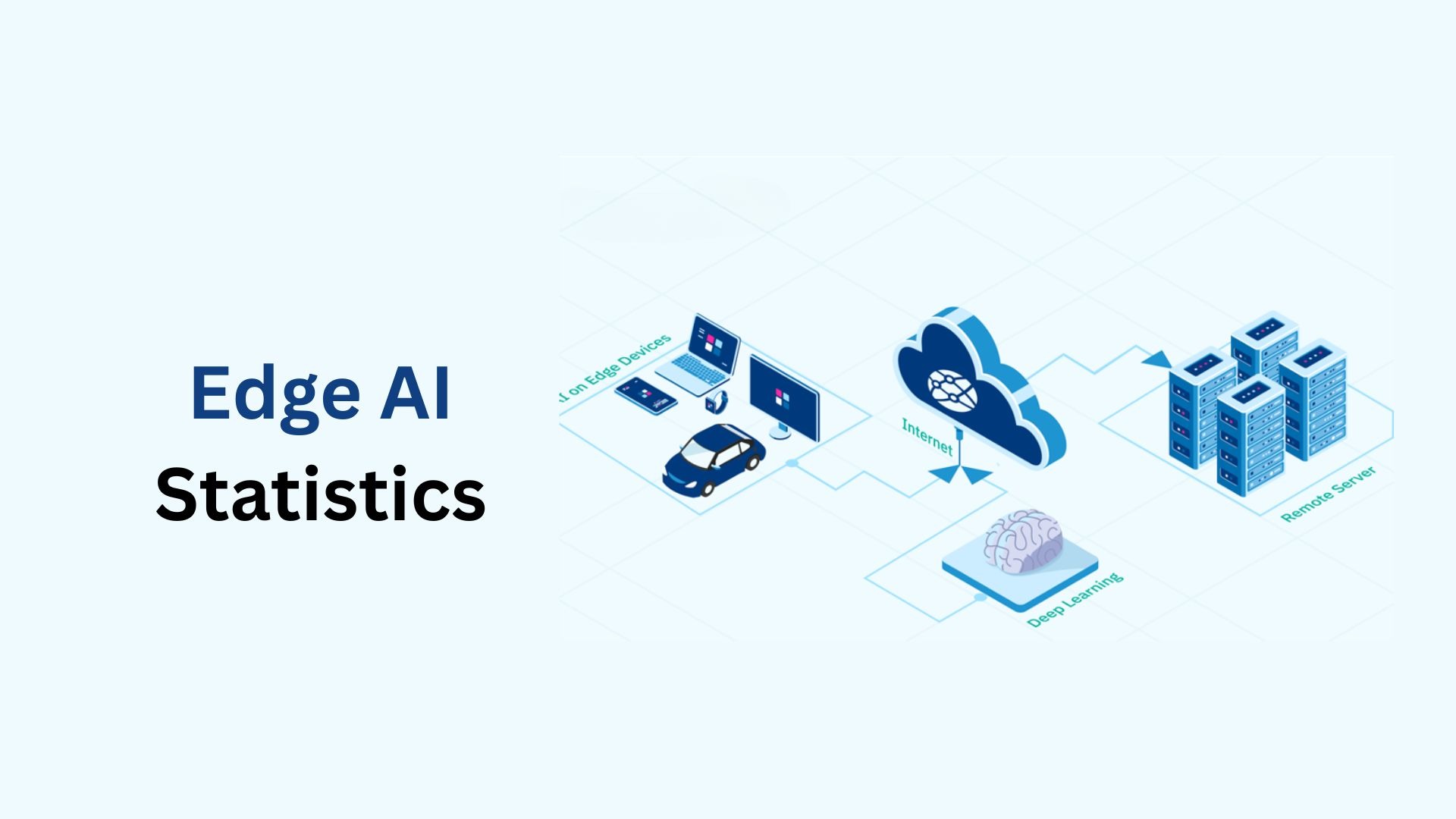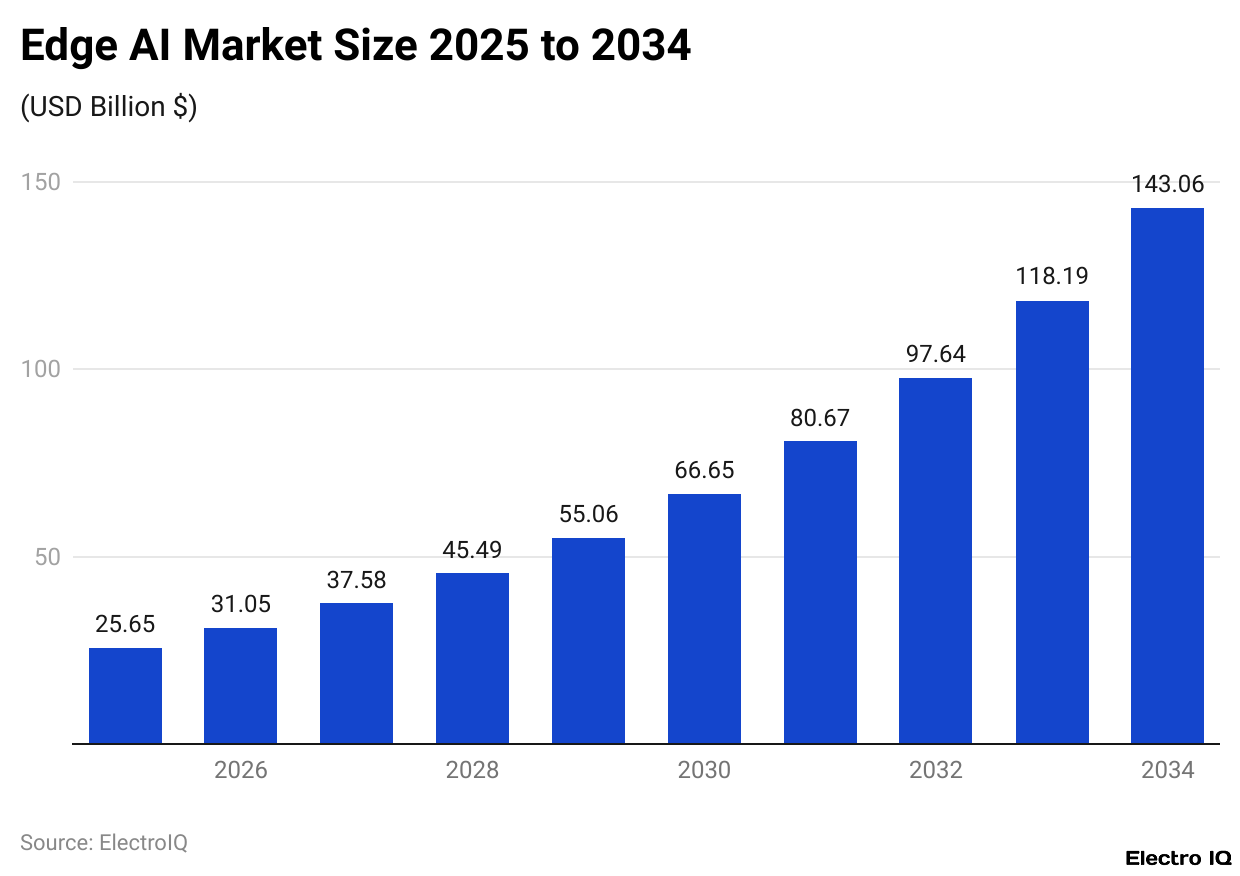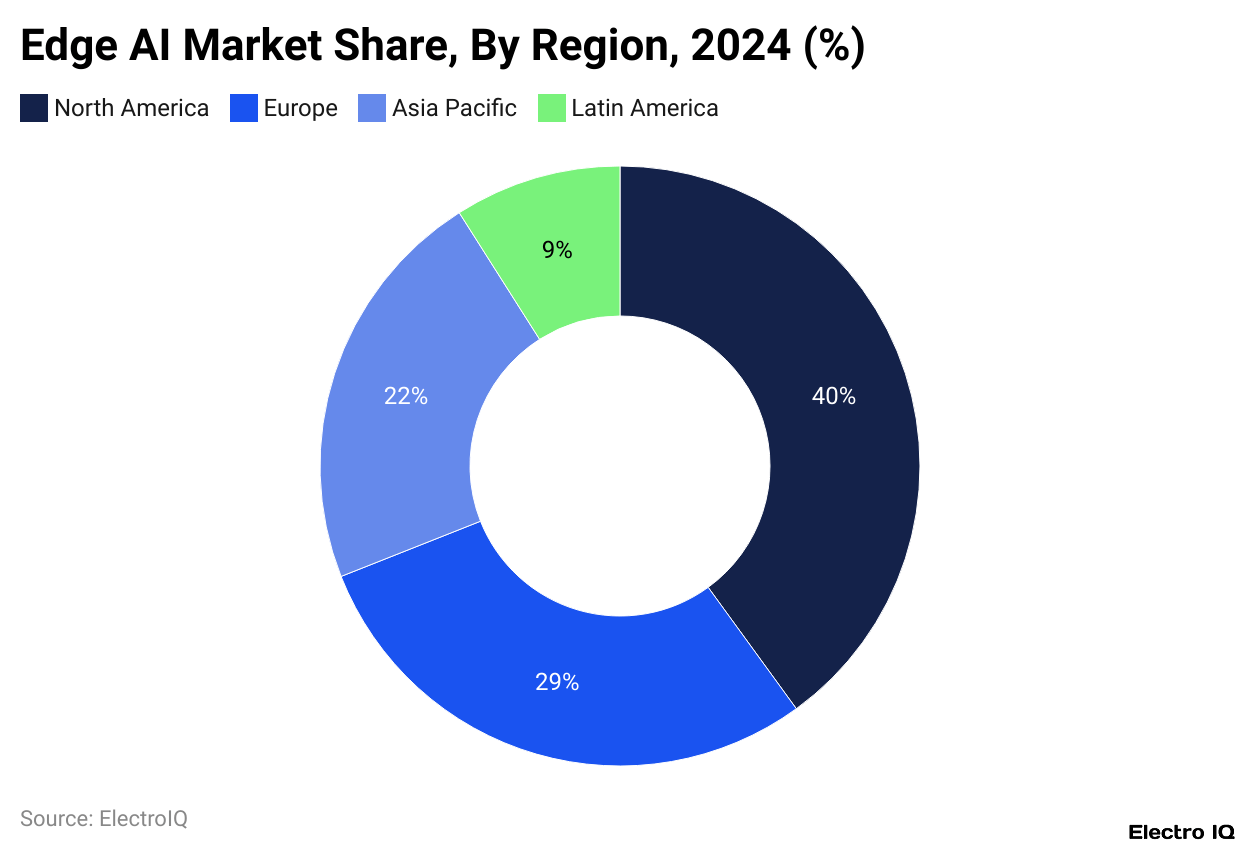Edge AI Statistics and Facts By Market Size, Region, Trends And Insights (2025)
Updated · Sep 14, 2025

Table of Contents
Introduction
Edge AI Statistics: Edge AI basically means doing artificial intelliNVIDIAgence directly at the edge devices—it could be a phone, a camera, or a sensor; a torturous way to say factory machines—meaning artificial intelligence at the edge in contrast to a cloud server. Now, gone are the days of Edge AI remaining experimental niche projects.
In 2024, it entered commercial entities and became a suitable choice for organisations whenever the edge solution mitigated latency, conserves bandwidth, protects privacy, and allows continuous working at the edge even with poor network connectivity. In this article, we will discuss the key Edge AI statistics.
Editor’s Choice
- In 2024, the global edge AI market was valued at US$21.19 billion and is estimated to rise to US$143.06 billion by 2034, growing at a CAGR of 21.04% from 2025 to 2034.
- North America took the lead with a 40% market share (US$8.48 billion in 2024), followed by Europe with 29%, Asia Pacific having 22%, and Latin America with the remaining 9%.
- Initiation of 5G and edge computing infrastructures allows an ideal setting with 10x data rate, less than 10 ms of latency, and 30-40% of energy saving for real-time AI applications.
- In 2024, the software segment attained dominance. Facilities adopting edge AI software garnered efficiency improvements of 40%, as per NIST.
- The edge cloud infrastructure market is expected to reach US$20 billion by 2026 (DOE).
- Global edge computing spending was around US$228–232 billion in 2024, of which Edge AI forms a fast-growing part.
- The Edge AI hardware market was worth US$896 million in 2024, while the edge AI chips market went up to about US$3.0 billion, both having a promising growth outlook.
- Top industries for adoption include IT & telecom (~20%+ of revenue share), manufacturing, automotive, healthcare, retail, and smart cities.
- 91% of companies consider local data processing as a competitive advantage, whereas 74% consider their scaling of AI ineffective (BCG).
- September 2024 saw major launches in Edge AI with NVIDIA Jetson Orin X, Intel Movidius Myriad X2, and Google Edge TPU 3.0, all focused on faster, more efficient edge AI.
Edge AI Market Size

(Reference: precedenceresearch.com)
- As per Precedence Research, Edge AI statistics show a valuation of US$21.19 billion in 2024.
- The global edge AI market is expected to grow rapidly, reaching an approximate valuation of US$143.06 billion in 2034, marking a CAGR of 21.04% witnessed during 2025-34.
- A noteworthy factor is the growth witnessed in North America, with its regional market alone worth US$8.48 billion in 2024.
- This demand, coupled with a technological advancement, looks set to push further adoption in the next decade.
5G And Edge AI
- The rollout of 5G is inseparably linked to the growth of edge computing and Edge AI because many critical applications demand ultrafast data transfer with 100 percent reliability.
- Unlike in previous generations of network operators, 5G shall have much higher throughput, much lower latency, delivering data rates as much as ten times faster than what current networks can.
- This is very important for applications like autonomous vehicles, where real-time decision-making is dependent on receiving packets fast.
- For example, an autonomous vehicle may require end-to-end communication delays of less than 10 milliseconds, while accessing the cloud usually results in a delay of more than 80 milliseconds, which is far too slow for safe operation.
- Furthermore, besides wireless communications, edge computing provides the technology to meet these criteria through local processing on the device, which can treat data in less than a millisecond.
- Greater efficiency is also attained, requiring 30–40% less energy or, in some cases, five times less than using the cloud.
- These two technologies, 5G and edge computing, enable ultra-fast and demanding AI applications to be run in real-time, such as video analytics for smart surveillance and security, the industry of automated manufacturing systems, and smart farming of precision agriculture.
- All of these use cases require ultra-low-latency communication, where even minimal latency will impair performance.
Edge AI Market By Region

(Reference: precedenceresearch.com)
- North America claimed the largest share of 40% of the edge AI market in 2024, recognising it as the champion in advanced technology adoption and deployment of edge-based solutions.
- Coming in second is Europe with 29%, as increasing investments in automation, smart cities, and strong regulatory support for data privacy and security exist there.
- Asia Pacific accounted for 22%, a reflection of rapid growth as widespread commercialisation of 5G and industrial IoT projects coexist in large consumer electronics markets like China, Japan, and South Korea.
- Latin America represented the remaining 9%, a smaller share yet one that continues to expand as more businesses throughout the region are starting to adopt edge AI for industries such as retail, agriculture, and telecommunications.
Component Insights In The Edge AI Market
- In 2024, in terms of revenue, the software segment assumed prominence in the edge AI market due to the increased need for advanced data processing and AI applications in smart cities and industrial systems.
- As per the NIST, the stronger the edge AI software, the higher the aid in decision making and operational efficiency at the edge.
- NIST further says that AI software implemented at facilities on edge platforms could improve operational efficiency to an extent of 40%, which is why they are gaining ground so fast across industries.
- Apart from software, edge cloud infrastructure is also anticipated to witness high growth during the period 2024-34, owing to the growing demand for high computing power and low latencies, along with the gradual rise of distributed cloud solutions fostered by new network technologies.
- The Office of Energy Efficiency and Renewable Energy (EERE) of the DOE has said it was projected that the edge cloud infrastructure market would grow in size to US$20 billion by 2026.
Spending On AI Markets, Hardware, Adoption, And Regional Insights
- Edge AI is one component of the grander system that is edge computing.
- Estimation by IDC puts global spending in the field of edge computing at US$232 billion in 2024, and other sources put it close to US$228 billion, showing that while Edge AI is a smaller subsection of a colossal market, it is, in fact, one of the fastest-growing areas.
- According to MarketsandMarkets, the Edge AI hardware market was valued at a mere US$896 million in 2024.
- In contrast, the edge AI chips market was positioned at around US$3.0 billion and was expected to maintain a double-digit growth rate.
- Such a gap shows that embedded AI devices are almost everywhere, but the hardware investment is not all directed toward specialised chips.
- Spending patterns are diverse according to the industry and locality. IT & telecom, manufacturing, automotive, health care, retail, and smart cities are the key industries in Edge AI implementation, with IT & telecom commanding more than 20% of market revenue.
- Regions such as North America in 2024 held 30–38% of total shares, and thereafter Europe and Asia, where adoption is rapidly being propelled by large 5G rollouts and IoT projects.
- In terms of adoption value, surveys show a strong recognition of benefits: 91% of organisations believe that processing of data at the source gives them a competitive edge.
- However, while practical challenges still exist (as a BCG study discovered that 74% of companies have trouble scaling AI well).
- It implies that, although confidence in Edge AI is high, implementing it successfully in smooth, large-scale operations remains a challenge.
Recent Developments
- Several leading technology players launched the products to strengthen Edge AI markets in September 2024.
- NVIDIA launched Jetson Orin X, a state-of-the-art platform that would accelerate real-time processing of data for autonomous systems, smart cities, etc.
- The platform employs a powerful AI processor with enhanced efficiency, hence being all the more relevant for automotive and robotics application sectors.
- Around this time, Intel also released the Movidius Myriad X2 module for high-performance edge computing, focusing on neural network processing and enhanced image recognition abilities for use-case scenarios such as smart cameras and industrial IoT devices.
- Also, Google Cloud jump-started with the launch of Edge TPU 3.0, its next-generation edge AI chip.
- The product is intended to accelerate machine learning model execution at the edge, reducing latency and enhancing real-time data processing in domains such as retail, healthcare, and smart-city infrastructure.
- These launches speak of the rapid innovations and competitive thrusts towards making edge AI more powerful, efficient, and general.
Future of Edge AI
- A thunderous theme ruling Embedded World 2024 was the growing importance of edge AI inside IoT systems.
- One could have witnessed from the event how increasingly easy it is to implement AI inferencing and how micro, thin, and thick edge AI levels bring intelligence closer to the network edges.
- Edge AI brings the data processing close to the source of generation, while mostly under the earlier cloud paradigm.
- This change reduces network traffic in the system, promotes time-critical decision-making for use cases like autonomous vehicles or manufacturing, and enhances privacy by keeping sensitive data local.
- With edge AI lessening dependency on large cloud providers, the technology is set to promote wider and more flexible adoption of AI through industries.
- Edge AI impact isn’t homogeneous; it varies with the level of application.
- Thick edge AI is heavy in running many AI inference models on a strong edge server or network gateway; it even allows for training or retraining of models with on-premises sensitive data.
- Thin edge AI makes existing devices and sensors smarter and performs AI tasks through a gateway, industrial PC, or controller at the network edge.
- Micro edge AI takes intelligence to the thinnest way by embedding AI within the sensor, thus enabling numerous connected devices to make quick and autonomous decisions.
- Together, these methodologies demonstrate that Edge AI can transform industries such as healthcare, automotive, and robotics by creating more decentralised, efficient, and intelligent systems.
Conclusion
Edge AI Statistics: Edge AI is currently undergoing a rapid transformation from experimental ventures into real-world applications spanning across industries. At present, with a market value of US$21.19 billion in 2024, it is expected to grow at a phenomenal rate to US$143.06 billion by 2034, and this growth is fueled by the interplay between 5G, edge computing, and a sophisticated AI hardware-software stack. Its positives include lower latency, better privacy, energy efficiency, and decisions being taken on the spot, which have made it a blessing for telecom, healthcare, automotive, and smart city domains.
In spite of all the emerging challenges in scaling, with interest at large from the organisations, with billions of dollars invested, and with innovations put in at a fast pace, Edge AI is here to stay as one of the strongest grandparents in any form of digital transformation.
Sources
FAQ.
Edge AI refers to deploying artificial intelligence models on edge devices such as smartphones, cameras, and industrial machines, instead of entirely relying on cloud support. This ensures minimal latency, bandwidth conservation, increased privacy, and devices functioning even if network connectivity becomes patchy at times.
Valued at US$21.19 billion in 2024, the deep analysis of the global Edge AI market reveals that between 2025 and 2034, it is expected to grow at a CAGR of 21.04% to US$143.06 billion by 2034. North America dominated the market with revenues worth US$8.48 billion, accounting for a 40% share, followed by Europe with 29%, Asia Pacific with 22%, and Latin America with 9%.
5G rollouts are one of the biggest drivers behind Edge AI adoption as they promise ultra-fast data transfer speeds, even 10 times faster than previous networks, and offer ultra-low latency of less than 10 ms. Complementing edge computing, which allows for local processing, 5G aids in better efficiency by reducing energy levels by 30-40%. Allowing these applications to perform real-time processing of complex AI workloads at the edge.
The major industries adopting Edge AI are IT and telecommunication, together accounting for more than 20% of market revenues. For instance, manufacturing employs edge AI for purposes like predictive maintenance and automation; healthcare for diagnosing and monitoring patients; and smart cities for surveillance and traffic control. Surveys indicate that some 91% of organisations consider processing data locally a competitive advantage; though, scaling AI is something that bothers 74% of them.
In September 2024, several big technology companies announced new edge AI solutions. NVIDIA announced the launch of its Jetson Orin X platform for real-time AI processing in fields such as robotics and autonomous vehicles. Intel, on the other hand, announced the unveiling of Movidius Myriad X2 to help next-gen image recognition and neural network tasks for IoT devices.

I hold an MBA in Finance and Marketing, bringing a unique blend of business acumen and creative communication skills. With experience as a content in crafting statistical and research-backed content across multiple domains, including education, technology, product reviews, and company website analytics, I specialize in producing engaging, informative, and SEO-optimized content tailored to diverse audiences. My work bridges technical accuracy with compelling storytelling, helping brands educate, inform, and connect with their target markets.










